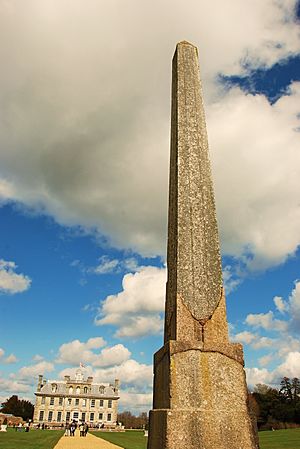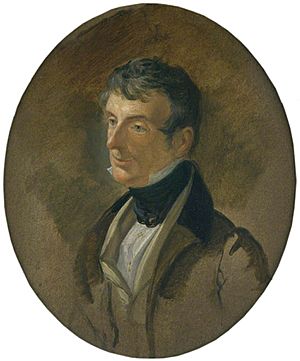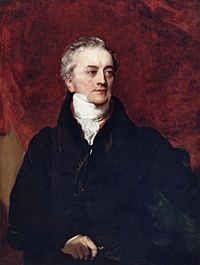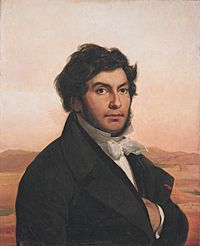Philae obelisk facts for kids

The Philae obelisk is a tall, stone pillar from ancient Egypt. It was one of two similar pillars built at a place called Philae in Upper Egypt around 200 BC. An explorer named William John Bankes found it in 1815. He had it moved all the way to his home, Kingston Lacy, in Dorset, England. The obelisk is still there today. It has writing in both Greek and Egyptian hieroglyphs. These writings were very important in helping experts figure out how to read ancient Egyptian hieroglyphs.
Contents
What it Looks Like
This obelisk was originally part of a pair. They stood at the entrance of the temple of Isis in Philae. Sadly, the other obelisk broke into many pieces a long time ago. The Philae obelisk we see today has a long main part, a small pyramid shape at the top, and a rectangular base. The very bottom part of the main shaft was fixed in modern times.
With its modern base, the obelisk stands about seven metres tall. It has two main types of writing. There is a hieroglyphic text carved on the main shaft. A Greek text is carved on the base. In 1815, people also saw some Greek writing painted on the base. But this has worn away over time because of the weather.
The writings on the obelisk tell an interesting story. They record a request from the Egyptian priests at Philae. They asked King Ptolemy VIII Euergetes and queens Cleopatra II and Cleopatra III for financial help. The temple was getting many visitors, and the priests needed money to manage them. The king and queens agreed and made the temple free from taxes. The Greek and Egyptian texts talk about the same event, but they are not exact translations of each other.
How it Came to England
William John Bankes discovered the obelisk in 1815. He was traveling in Egypt at the time. He quickly realized that having the same story in two languages would be super helpful. It could be a key to understanding Egyptian hieroglyphs. So, he decided to get the obelisk. He also collected a large broken piece of its twin.
An adventurer named Giovanni Belzoni helped Bankes move the huge stones. They were transported to Bankes's estate at Kingston Lacy in Dorset, England. The obelisk arrived in London in December 1821. This made it the very first Egyptian obelisk ever brought to the United Kingdom.
Moving such a large stone was a big job! Arthur Wellesley provided a special wagon to help. This wagon carried the obelisk to Kingston Lacy in 1829. Later, King George V gave Libyan granite. This stone was used to fix the base of the obelisk. The obelisk was finally set up in the gardens in 1830. It took nineteen horses to lift it into place! The broken piece of its twin was also placed nearby. It was left there to look like an old ruin.
In 1981, the obelisk, along with the house and estate, was given to the National Trust. It is now a Grade II* listed building, which means it's a very important historical structure.
Cracking the Hieroglyphic Code
The Philae obelisk was incredibly important for understanding hieroglyphs. Some people even called it "a second Rosetta Stone." While the obelisk was in London, an artist named George Scharf made many copies of it. These copies showed its inscriptions in detail. Bankes shared these copies with other scholars who were trying to decipher hieroglyphs.
One of these scholars was Thomas Young. He had been studying the Rosetta Stone. He already knew that special oval shapes called cartouches often held the names of Pharaohs. He had even identified the name 'Ptolemy'. Bankes looked at the copies of the Philae obelisk. He thought he saw the name 'Cleopatra' in some of its cartouches. However, progress was slow because the Greek and Egyptian texts were not exact translations. Also, Bankes and Young mistakenly thought that hieroglyphs were only pictures representing whole words.
Meanwhile, in France, Jean-François Champollion was also working hard on deciphering hieroglyphs. He had studied another ancient Egyptian writing style called demotic. Based on his work, he had guessed what the hieroglyphs for 'Cleopatra' might look like. When Jean-Antoine Letronne sent him a copy of the Philae obelisk's inscriptions, it proved Champollion's guess was right!
Champollion announced his amazing discovery in 1822. He explained how to read hieroglyphs. Bankes and Young were not happy. They felt Champollion didn't give them enough credit. Later, other scholars like Karl Richard Lepsius and Ulrich Wilcken also studied the obelisk. They published its texts. Wilcken noted that the painted Greek inscription was no longer visible by his time.
Modern Digital Research

By 2014, the inscriptions on the obelisk were very worn down. The Greek writing, especially, was hard to see with just your eyes. So, in 2014 and 2015, experts used new technology to study it. Ben Altshuler from the Institute for Digital Archaeology worked with Alan Bowman and Charles Crowther from Oxford University. They used special RTI scans and 3D imaging.
These scans showed that the old copies made by George Scharf were very accurate. The new scans also helped them make "small corrections" to the recorded Greek text. They even found some possible tiny traces of the painted Greek writing that had been lost.
The Philae obelisk is famous for its two languages. Because of this "translation" idea, it even inspired the name of a space mission! The Rosetta space mission had a robotic lander called Philae. This lander arrived at a comet called 67P/Churyumov–Gerasimenko in 2014. It landed on the comet later that year.
See also
 In Spanish: Obelisco de File para niños
In Spanish: Obelisco de File para niños




